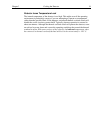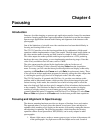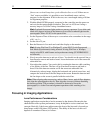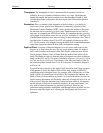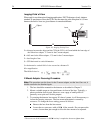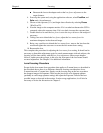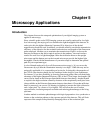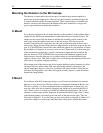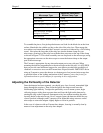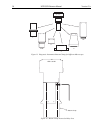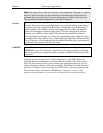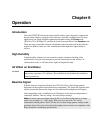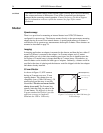
Chapter 5
Microscopy Applications
Introduction
This chapter discusses the setup and optimization of your digital imaging system as
applied to microscopy.
Since scientific grade cooled CCD imaging systems are usually employed for low light
level microscopy, the major goal is to maximize the light throughput to the detector. In
order to do this, the highest Numerical Aperture (NA) objectives of the desired
magnification should be used. In addition, you should carefully consider the transmission
efficiency of the objective for the excitation and emission wavelengths of the fluorescent
probe employed. Another way to maximize the transmission of light is to choose the
detector port that uses the fewest optical surfaces in the pathway, since each surface
results in a small loss in light throughput. Often the trinocular mount on the upright
microscope and the bottom port on the inverted microscope provide the highest light
throughput. Check with the manufacturer of your microscope to determine the optimal
path for your experiment type.
A rule of thumb employed in live cell fluorescence microscopy is “if you can see the
fluorescence by eye, then the illumination intensity is too high”. While this may not be
universally applicable, it is a reasonable goal to aim for. In doing this, the properties of
the CCD in your detector should also be considered in the design of your experiments.
For instance, if you have flexibility in choosing fluorescent probes, then you should take
advantage of the higher Quantum Efficiency (QE) of the CCD at longer wavelengths (QE
curves can be found on the Princeton Instruments detector data sheets). Another feature
to exploit is the high resolution offered by detectors with exceptionally small pixel sizes
(data available on the Princeton Instruments detector data sheets). Given that sufficient
detail is preserved, you can use 2x2 binning (or higher) to increase the light collected at
each “super-pixel” by a factor of 4 (or higher). This will allow the user to reduce
exposure times, increasing temporal resolution and reducing photodamage to the living
specimen.
Another method to minimize photodamage to biological preparations is to synchronize a
shutter on the excitation pathway to the exposure period of the detector. This will limit
exposure of the sample to the potentially damaging effects of the excitation light.



